
Scaevola glandulifera, the viscid hand-flower, is a shrub in the family Goodeniaceae, endemic to Western Australia.

Scaevola cunninghamii is a spreading perennial plant in the family Goodeniaceae.

Leucopogon tamminensis is a species of flowering plant in the heath family Ericaceae and is endemic to the southwest of Western Australia. It is a slender shrub with many branches, overlapping triangular to egg-shaped leaves and white, tube-shaped flower arranged singly in upper leaf axils.
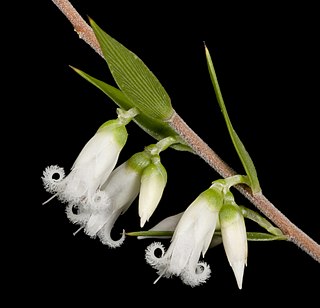
Styphelia conostephioides is a flowering plant in the family Ericaceae and is endemic to the south-west of Western Australia. It is an erect, straggling shrub with lance-shaped leaves with a sharp point on the tip, and white flowers arranged in pairs in leaf axils.
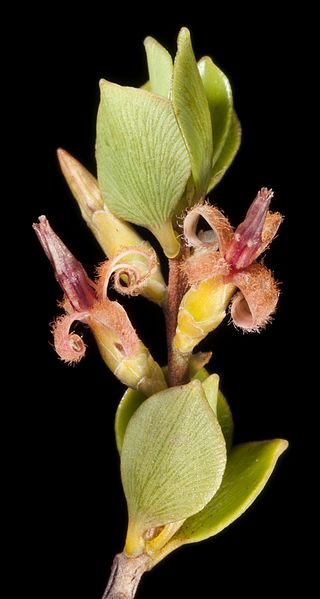
Styphelia coelophylla is a plant in the family Ericaceae endemic to the south west of Western Australia. It is an erect, bushy shrub with egg-shaped to lance-shaped leaves and tube-shaped flowers.

Leucopogon assimilis is a species of flowering plant in the family Ericaceae and is endemic to the south of Western Australia. It is an erect, slender shrub with linear or lance-shaped leaves and pink to white, tube-shaped flowers.

Leucopogon capitellatus is a species of flowering plant in the heath family Ericaceae and is endemic to the south-west of Western Australia. It is an erect, more or less glabrous shrub that typically grows to a height of 0.2–1 m. It has linear to lance-shaped leaves longer than about 12 mm (0.47 in) long, tapering to a rigid point on the tip. The flowers are borne on short spikes on the ends of branches or in leaf axils on short side branches, with small bracts and bracteoles about half as long as the sepals. The sepals are broad, about 2 mm (0.079 in) long and the petals white and about 4 mm (0.16 in) long, the petal lobes longer than the petal tube.
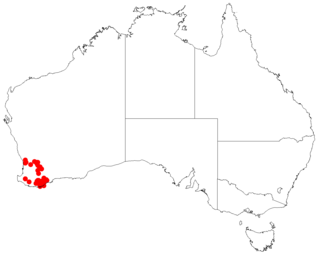
Styphelia cymbiformis is a flowering plant in the family Ericaceae and is endemic to the south-west of Western Australia. It is a bushy or wiry shrub that typically grows to a height of 30–50 cm (12–20 in) and has more or less glabrous branches. Its leaves are erect, linear to lance-shaped and sharply-pointed, mostly 2–4 mm (0.079–0.157 in) long. The flowers are arranged in short spikes, sometimes of only two or three flowers, with lance-shaped, leaf-like bracts, and bracteoles half as long as the sepals at the base of the spikes. The sepals are 2.5–3.0 mm (0.098–0.118 in) long and the petals slightly longer than the sepals, the lobes shorter than the petal tube.

Leucopogon gilbertii is a species of flowering plant in the heath family Ericaceae and is endemic to the south-west of Western Australia. It is a slender shrub with linear to lance-shaped leaves and spikes of tube-shaped white flowers on the ends of branches and in leaf axils.

Leucopogon glabellus is a species of flowering plant in the family Ericaceae and is endemic to the south-west of Western Australia. It is an erect, glabrous shrub with slender branchlets, heart-shaped to lance-shaped leaves, and cylindrical spikes of white flowers.

Leucopogon gnaphalioides is a species of flowering plant in the heath family Ericaceae and is endemic to the south-west of Western Australia. It is a slender or sprawling shrub with crowded egg-shaped to lance-shaped leaves and spikes of tube-shaped white flowers on the ends of branches and in upper leaf axils.

Leucopogon insularis is a species of flowering plant in the heath family Ericaceae and is endemic to the south-west of Western Australia. It is a rigid, scrubby shrub with many branches, linear or oblong leaves and tube-shaped, white flowers.
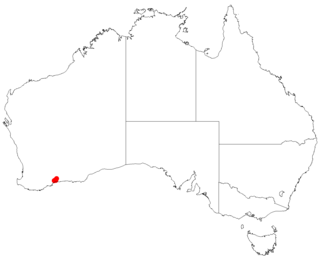
Leucopogon lloydiorum is a species of flowering plant in the heath family Ericaceae and is endemic to the south-west of Western Australia. It is a slender shrub with elliptic leaves clustered near the ends of branchlets, and white, densely-bearded, tube-shaped flowers.

Leucopogon mollis is a species of flowering plant in the heath family Ericaceae and is endemic to the south-west of Western Australia. It is a slender, diffuse shrub that typically grows to a height of 0.3–1 m and has white, tube-shaped flowers. The species was first formally described in 1904 by Ernst Georg Pritzel in Botanische Jahrbücher für Systematik, Pflanzengeschichte und Pflanzengeographie from specimens collected on the summit of "Mount Mongerup" in the Stirling Range. The specific epithet (mollis) means "soft".
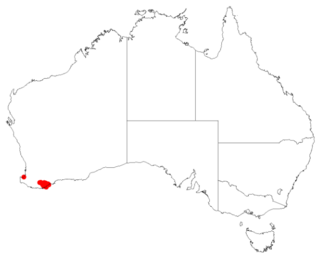
Leucopogon penicillatus is a species of flowering plant in the heath family Ericaceae and is endemic to the south-west of Western Australia. It is an slender, erect, spreading shrub with egg-shaped to narrowly triangular leaves and white, bell-shaped, bearded flowers arranged in groups of between 3 and 13.

Leucopogon racemulosus is a species of flowering plant in the heath family Ericaceae and is endemic to the south-west of Western Australia. It is an erect, rigid shrub with linear leaves and white, tube-shaped flowers usually arranged in pairs or threes in leaf axils.
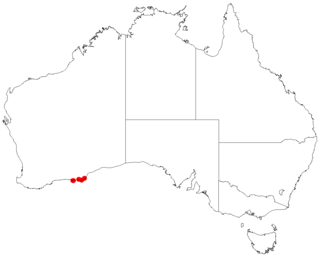
Leucopogon rigidus is a species of flowering plant in the heath family Ericaceae and is endemic to the south of Western Australia. It was first formally described in 1839 by Augustin Pyramus de Candolle in his Prodromus Systematis Naturalis Regni Vegetabilis from an unpublished description by Allan Cunningham. The specific epithet (rigidus) means "hard" or "stiff", probably referring to the branchlets. Leucopogon rigidus is found in the Esperance Plains bioregion of southern Western Australia and is listed as "not threatened" by the Western Australian Government Department of Biodiversity, Conservation and Attractions.
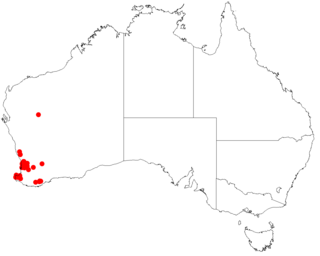
Leucopogon tenuis is a species of flowering plant in the heath family Ericaceae and is endemic to the southwest of Western Australia. It is an erect shrub with slender, wand-like branches, linear or narrowly lance-shaped leaves and white, tube-shaped flowers arranged in cylindrical spikes on the ends of branches.
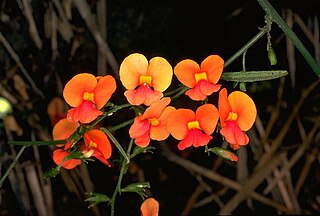
Chorizema diversifolium is a species of flowering plant in the family Fabaceae and is endemic to the southwest of Western Australia. It is a twining or trailing shrub or climber with variably-shaped, egg-shaped to narrowly lance-shaped leaves and pink, orange and red flowers.
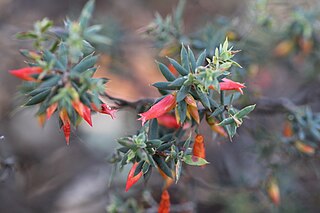
Styphelia epacridis is a flowering plant in the family Ericaceae and is endemic to the south-west of Western Australia. It is a straggling shrub with lance-shaped or linear leaves with a sharp point on the tip, and red, tube-shaped flowers arranged singly in leaf axils.





















